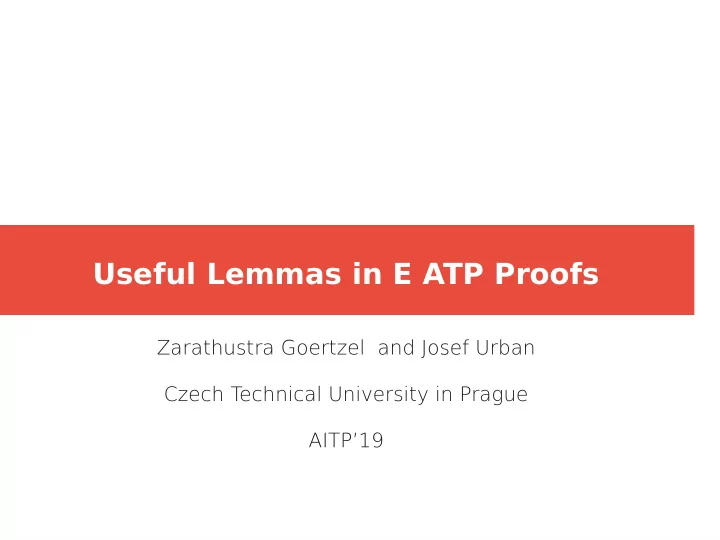

Useful Lemmas in E ATP Proofs Zarathustra Goertzel and Josef Urban Czech T echnical University in Prague AITP’19
Outline of talk ● What are lemmas and why do they matter? ● Quantifying lemma usefulness. ● Machine learning to identify lemmas. ● Conclusion. 2
Lemmas Lemmas are: ● True statements ● Intermediate results ● Sometimes used in multiple theorems Why seek lemmas? ● ATPs struggle to fjnd long proofs. ● Conjecturing new (interesting) results. ● Concise presentations of proofs. 3
Lemmas as Cuts Given axiom set Γ and conjecture C, we want to prove . We call L a lemma if the following holds: * This doesn’t require L be a “useful lemma”. 4
Lemmas via Excluded Middle E is a refutational theorem prover and tries to derive a contradiction: . Therefore the problem can be broken into two sub-problems: 5
Lemma Usefulness: Proof Shortening Ratio If the two sub-problems can be solved (by E) with psr(L, Γ, C) < 1, L can be said to be a useful lemma. 6
Dataset: Built From E Proofs ● E’s a saturation-based refutational ATP . ● Goal: Prove conjecture from premises. ● E has two sets of clauses: ● Processed clauses P (initially empty) ● Unprocessed clauses U (Negated Conjecture and Premises) ● Given Clause Loop: ● Select ‘ given clause ’ g to add to P ● Apply inference rules to g and all clauses in P ● Process new clauses. Add non-trivial and non-redundant ones to U. ● Proof search succeeds when empty clause is inferred. ● Proof consists of given clauses. 7
Down and Dirty with the Datset ● 3161 CNF problems from Mizar 40 dataset ● Proved by single E strategy ● For each clause of proof P , solve both sub- problems. ● 230528 clauses in total 8
Lemma Stats Of the 230528 clauses: ● 98472 are axioms and negated conjectures. ● 87161 are anti-useful lemmas ● 44895 are useful lemmas ● 154 have psr(L, Γ, C) = 1 9
Lemma Stats ● Best lemma’s psr: 0.0036 (275 times faster) ● Worst lemma: 77 times slower ● Number of lemmas under 0.1: 1509 10
Lemma Classifjcation Why? ● To gauge the diffjculty of the dataset ● Clear yes/no results compared to regression Possible use-cases: ● Proof compression for E inference guidance ● Analyze incomplete proof-search to look for lemmas 11
Clauses Vectors ● Treat clause as tree. Abstract vars and skolem symbols ● Features are descending paths of length 3 12
Clauses Vectors Enumerate features (→ R^|Features| vector space) Count features in a clause for its vector 13
ML Methods ● Support Vector Machine Classifjer (SVC) from scikit-learn ● XGBoost: gradient boosted random decision forest: ● SVC and XGBoost use |Clause ++ Conjecture| Enigma features. ● Graph Attention Networks (GAT): ● Assign labels or numbers to nodes via the graph structure. ● At each level, a node’s features depend on its neighbors. ● Drawback: graph adjacency matrix, large memory consumption ● Question: Will the proof-graph structure help identify lemmas? 14
Results F score F score 15 Images courtesy of https://en.wikipedia.org/wiki/F1_score
Results F-score Precision Recall Accuracy SVC 0.53 0.45 0.64 0.74 GAT 0.55 0.45 0.72 0.55 XGBoost 0.68 0.65 0.72 0.77 Precision and Recall are with Precision and Recall are with Results are on a 10% test set. Results are on a 10% test set. respect to useful lemmas. respect to useful lemmas. 16
Conclusions ● GAT appears not to scale, and the proof-graph is not efgectively utilized. ● XGBoost is cheap to train and suffjciently efgective as to be used in further experiments with E. Todo: ● Learn more semantic features ● Work on generating lemmas 17
18
Recommend
More recommend